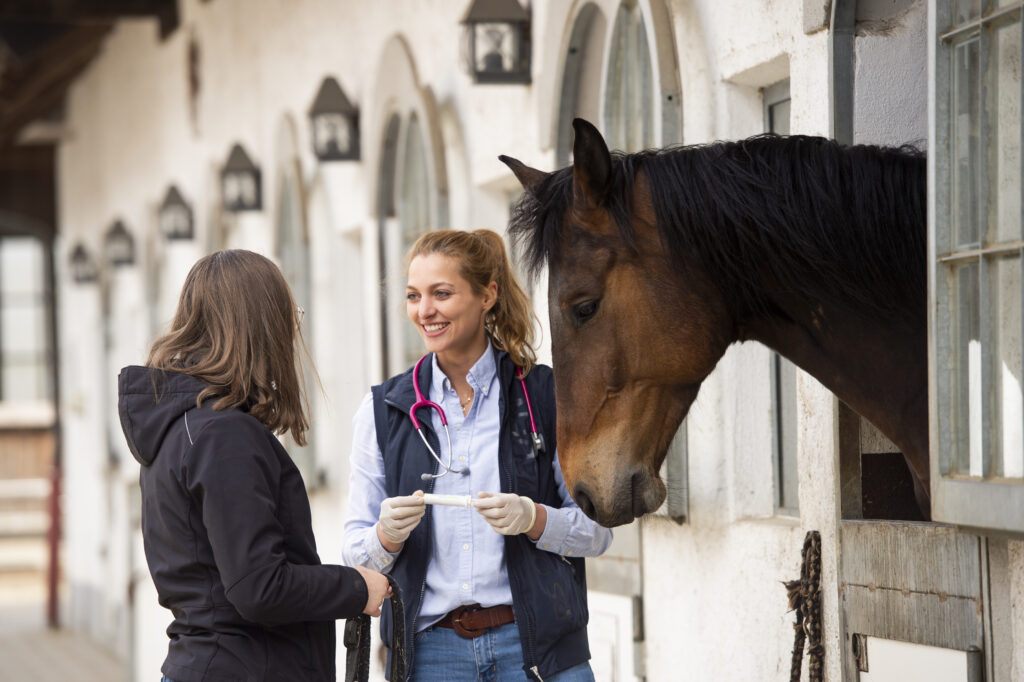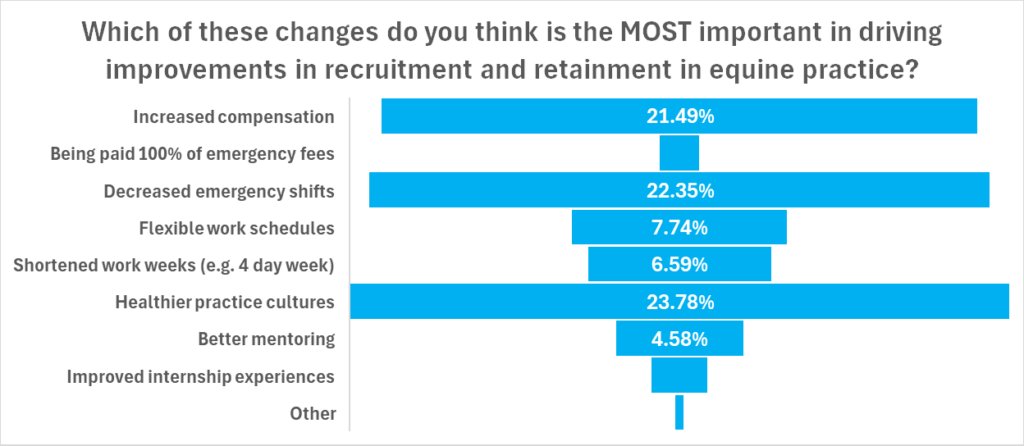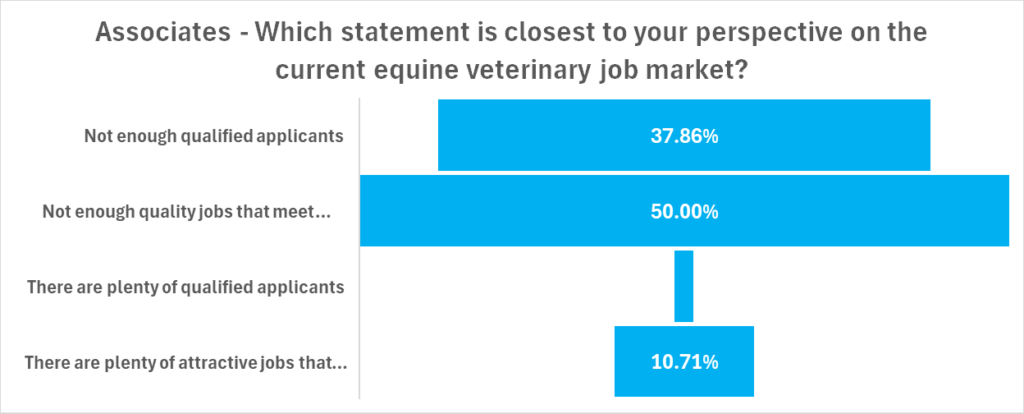This article originally appeared in the Winter 2024 issue of EquiManagement. Sign up here for a FREE subscription to EquiManagement’s quarterly digital or print magazine and any special issues.

Although the last several years have seen many efforts to increase the sustainability of equine practice, many veterinarians in the trenches are not feeling much change. In a short survey distributed on the Facebook site Equine Vet2Vet, equine practitioners weighed in on whether they thought progress was being made. Of the 350 respondents, more than half (54%) did not think much progress had occurred (see Figure 1).
In thinking about this result, consider that people are sometimes unaware of the experiences of others. “I agree that the response to the survey question is disappointing,” says Katie Garrett, DVM, DACVS, AAEP President and director of diagnostic imaging at Rood and Riddle Equine Hospital in Lexington, Kentucky. She offered a plausible explanation that was recently put forth by the authors of an article in JAVMA about work-life balance. One of the findings in the study was that ~75% of respondents were very, extremely, or somewhat satisfied with their job, but only 43% perceived that their peer veterinarians were very, extremely, or somewhat satisfied. The authors said they “found it surprising that there was such a disconnect between the level of job satisfaction veterinarians felt and their more negative perceptions of how their peers felt. Could there be a culture of negativity at veterinarian gatherings that feeds on itself? Or, given the recent increase in demand for veterinary services and resulting stress, perhaps some assumed their peers were somehow less resilient.”
Garrett says she “wonders if there might be something similar in responses to the survey question about progress—people think that things ‘out there’ are worse than they are.”

Most Important Factors in Driving Improvement
When asked “Which of these changes do you think is the most important in driving improvements in recruitment and retainment in equine practice?”, respondents ranked three elements as most important: Healthier practice cultures, decreased emergency shifts, and increased compensation (see Figure 2). While new paradigms are most certainly afoot, many equine practitioners might be working at long-established practices that are resistant to change.

Healthier practice cultures are essential for the equine veterinary industry, where a 24/7/365 lifestyle has long been the norm. With research showing that workers in the U.S. value time to live a life outside of work as highly as they do compensation, change is necessary. Millennials and Gen Z employees work to live rather than live to work. Many experts believe employers will need to change the work to fit the workers.
Frequent emergency duty is a task many early-career veterinarians are increasingly unwilling to sign on for. Being on call for 24-hour shifts with scheduled appointments the next day can leave doctors exhausted and depleted. They miss out on family events, and their relationships and mental health suffer. Many new paradigms for providing emergency service are taking hold in modern practices, but in some areas practice owners still hold to traditional ways.
Companion vs. Equine Compensation
With educational debt averaging $184,858 among equine graduates with debt, adequate compensation is also a concern. In 2023, average salary (not including benefits or emergency fees) for graduating veterinarians entering equine associate positions without internships rose to $94,678 from $69,830 in 2022 and $54,513 in 2021. This has brought the debt-to-income ratio (DIR) down to an acceptable level of 1.7 for equine graduates, not including those in internships. However, the 2023 average starting salary for graduates entering companion-animal-exclusive practice was above $130,000, which is undoubtedly attractive to many equine track graduates.
Companion animal positions offer all legs of the stool—higher compensation, fewer weekly shifts, and minimal after-hour responsibilities. It is no wonder some feel they must leave equine practice to live their best lives. Those who choose to enter equine practice have often dreamed of being horse doctors since childhood. The love of these magnificent animals is a strong motivator to stay, but we must make a career in equine practice more compatible with a full life beyond work, as well as provide heathy cultures and comparable compensation.
Availability of Quality Positions in Equine Practice
Interestingly, when asked, “Which statement is closest to your perspective on the current equine veterinary job market?” half of associates (41% of the respondents) said there are not enough quality positions available (see Figure 3). Practice owners (46% of respondents) responded that there are not enough quality applicants (see Figure 4).


The disparity between associates’ and practice owners’ perspectives highlights the importance of each group’s priorities. Associates seem to be indicating that the positions offered lack the things they care about most. The practice owners are experiencing both an absolute drop in the numbers of applicants and perhaps a lack of applicants who want a traditional position.
Transforming Equine Practice

In response to the downward trend of attracting and retaining equine practitioners over the past decade, in 2021 the AAEP made this the top priority of its strategic plan. After initial work researching and gathering data, the AAEP formed the AAEP Commission on Equine Veterinary Sustainability in 2022 as part of a campaign to transform and sustain equine practice. The Commission was charged with developing, overseeing, and helping execute programs designed to increase the sustainability of equine practice for the betterment of the veterinarian and the welfare of the horse.
The Commission comprised five subcommittees developed around the key areas affecting the sustainability of equine practice, as identified in previous research: Compensation, Emergency Coverage, Students, Internships, and Practice Culture. Each subcommittee had co-chairs, an officer liaison, and 12-15 members. The Commission was governed by a steering committee consisting of the AAEP officers and the chairs of each subcommittee. The subcommittees concentrated on program development and implementation to transform equine practice. The goals included increasing the number of graduates entering equine practice, the number of equine practitioners remaining in the equine space five years after entry, the compensation equine veterinarians earn at entry and in their first five years, and the number of equine doctors who would recommend equine practice as a career to others. In addition, there is a need to decrease the burden of emergency care, minimize burnout, increase satisfaction with the internship experience, and develop healthier practice cultures, professional boundaries, and well-being. The AAEP Commission subcommittees developed a remarkable library of resources over the last two years.
Around the country, a number of equine practices have adopted new paradigms and are thriving. Ryan Ferris, DVM, DACT, co-owns Summit Equine, in Gervais, Oregon, with his wife, Dora Ferris, DVM, DACVSMR. Together they have structured their business to succeed by leveraging their nonveterinarian team to perform all the tasks that do not require a doctoral degree. This efficiency has allowed them to absorb the strong demand for their services and invest in new technologies, such as a standing CT. Ferris says he’s excited about the opportunities this presents “to remodel equine practice for once in a way that can support veterinarians and staff not grinding away for months.
“I do think this will be a slow transition into the future, much like the tides changing in the ocean,” he says. “The tide has clearly gone out, and equine practice is adjusting. The unknown is whether the tide is completely out and starting to come in, or do we still have a period of more tide to go out?”
On the other side of the country in Palm City, Florida, Carolyn Todd, BVMS, MRCVS, and her husband, Edgardo Fullana, DVM, co-own Harbour Ridge Equine, now a five-doctor practice. After a difficult period with the loss of several associates, the couple revisited all aspects of their practice with the goal of creating a sustainable model for the future. Their work was rewarded with eager interest in their associate positions, which filled quickly. In fact, they moved up from two associates to three when they were blessed with great applicants and decided to just “go for it!”
Todd describes their compensation package as “a solid base salary with production bonuses, three weeks of paid vacation, and an annual raise of base salary in line with the Consumer Price Index.” The owners take one week each month off from work to spend time together, allowing them “to demonstrate a ‘type of lifestyle’ that associates might like to see themselves enjoying.”
In her recent experience with hiring associates, Todd says she’s found the elements most important to them are “having a four-day workweek, plenty of personal time to travel, working significantly less hours than at previous positions, and making more money. Our on-call schedule is one out of every four which has been possible by using an outside emergency service provider to cover a regular number of nights and weekends.”
Todd and Fullana also took a structured leadership course together, which helped them build a stronger team. “All team members create professional objectives that help the practice to succeed, and we hold individual meetings every ninety days with all employees to ‘check in’ and see how they are doing professionally and personally, as well as listen to their wins and challenges,” says Todd.
As a result of their efforts, “We are happier, and there is a far more positive practice culture,” she adds. “I am also mindful that in order for the practice to succeed, I must not be the biggest producer and that the owners working less is actually a positive indicator for practice success.”
Bottom Line
When asked about her hopes for the future of equine practice, 2024 AAEP President Dr. Garrett replied, “Over the past few years, the AAEP has committed substantial resources to helping the profession address the challenges of attracting and retaining equine veterinarians. We know that no solution is a quick fix, as increasing job satisfaction across our industry is a complex process that can take quite a bit of time to result in widespread impact. However, we are encouraged by the positive responses we have received from practices and individuals that have made proactive changes and are hopeful that this momentum can continue.”
Reference
Volk, J. O., Schimmack, U., Strand, E. B., Reinhard, A., Hahn, J., Andrews, J., Probyn-Smith, K., & Jones, R. (2024). Work-life balance is essential to reducing burnout, improving well-being. Journal of the American Veterinary Medical Association, 262(7), 950–957. https://doi.org/10.2460/javma.24.02.0135
Related Reading
- Equine Veterinary Sustainability: The New AAEP Early Career Committee
- The Top Factors Influencing Equine Veterinarians’ Job Satisfaction
- Veterinary Sustainability: An Update on the AAEP Commission’s 5 Subcommittees
Stay in the know! Sign up for EquiManagement’s FREE weekly newsletters to get the latest equine research, disease alerts, and vet practice updates delivered straight to your inbox.




